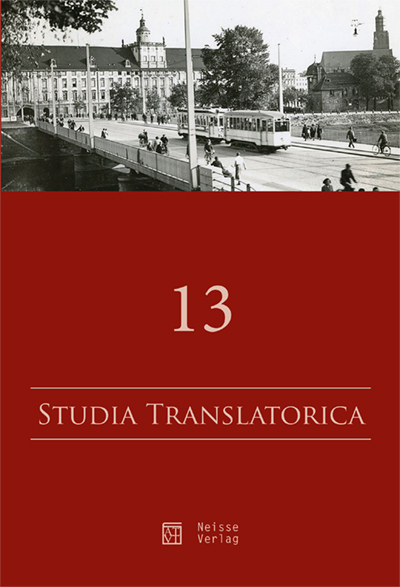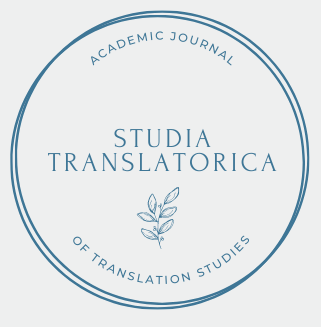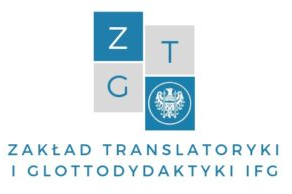
Studia Translatorica
Numer 13 (2022): Teraźniejszość i przyszłość badań nad translacją – współczesne trendy oraz kierunki rozwoju. The Present and Future of Translation Studies – Current Trends and New Directions. Gegenwart und Zukunft der Translationsforschung – Aktuelle Trends and Entwicklungstendenzen
Redakcja: Anna Małgorzewicz, Michał Gąska, Kwiryna Proczkowska
Tłumacza obcowanie z obcością w translacji / Translator’s dealing with foreignness in translation
DOI: 10.23817/strans.13-1 (data publikacji online: 2022-12-11)
Data przesłania artykułu do redakcji: 2022-03-21
Data przyjęcia artykułu do druku: 2022-07-26
Słowa kluczowe: foreignness in translation, ontological, semiotic and communication dimension, model of translation situation, translation task, ontological and semiotic transcendence/transcending
The following text transparently shows the specific nature of foreignness in translation by special regard to its ontological and processual relativism within the dynamic model of translation relationship. This article outlines the complex character of foreignness on the one hand and on the other the details of singular operations as translator’s management in the process of translation. The author bases his interpretation on the polish Anthropocentric Theory of Translation.
Wierność przekładu z perspektywy źródeł prawa oraz Kodeksu zawodowego tłumaczy przysięgłych / Accuracy of translation from the perspective of legal sources and the Professional Code of Sworn Translators
DOI: 10.23817/strans.13-2 (data publikacji online: 2022-12-11)
Data przesłania artykułu do redakcji: 2022-02-25
Data przyjęcia artykułu do druku: 2022-07-25
Słowa kluczowe: translation of legal acts, translational approaches, quality of translation, translational dispositions
The introductory part of the paper discusses legal sources and court rulings in relation to the assessment of the quality and principles of translation of written texts. The main part contains a critical analysis of selected translational dispositions contained in the Professional Code of a sworn translator and their impact on the approach to the translation of legal and other texts.
Ken Liu’s subjectivity in the English translation of “Santi” from the perspective of Eco-translatology / Ken Liu’s subjectivity in the English translation of “Santi” from the perspective of Eco-translatology
DOI: 10.23817/strans.13-3 (data publikacji online: 2022-12-11)
Data przesłania artykułu do redakcji: 2022-03-08
Data przyjęcia artykułu do druku: 2022-07-25
Słowa kluczowe: Santi (The Three-Body Problem), Ken Liu, translator’s subjectivity, Eco-translatology, selection, adaptation
“The Three-Body Problem”, English version of the Chinese novel “Santi”, is the first translated novel to have received “Hugo Award for Best Novel”, the world’s best laurel for science fiction. This paper studies how the translator Ken Liu’s subjectivity contributed to the success of the translation from the perspective of Eco-translatology. The study focuses on how Ken Liu adapted himself to the translational eco-environment and what translation strategies and skills he selected in the linguistic, cultural, and communicative dimensions. Moreover, the quality of the translation is evaluated with the criteria proposed in Eco-translatology. With the help of Python, a quantitative and qualitative analysis of readers’ comments on “The Three-Body Problem” is conducted. The research finds that (1) In the adaptation stage, Ken Liu was not passively constrained by the translational eco-environment. His subjectivity based on his bilingual and bicultural competence satisfied both his own internal requirements and the external requirements of the translational eco-environment; (2) In the selection stage, Ken Liu creatively succeeded in achieving the correspondence between the source text and target text in the linguistic, cultural and communicative dimensions; (3) The English version of “Santi” has survived in the western translational eco-environment by way of a high degree of holistic adaptation and selection.
Interpunctive analysis in the interlingual subtitles of “Manbiki kazoku” (2018, Kore’eda Hirokazu): A comparison between Japanese and four European languages / Interpunctive analysis in the interlingual subtitles of “Manbiki kazoku” (2018, Kore’eda Hirokazu): A comparison between Japanese and four European languages
DOI: 10.23817/strans.13-4 (data publikacji online: 2022-12-11)
Data przesłania artykułu do redakcji: 2022-03-02
Data przyjęcia artykułu do druku: 2022-07-12
Słowa kluczowe: prosubs, interlingual subtitling, Japanese-Italian subtitling, punctuation
This contribution intends to investigate punctuation in the prosubs of the Japanese feature film “Manbiki Kazoku” (Kore’eda Hirokazu, 2018) by comparing it with the English, Italian, French and Spanish versions in order to trace trends and points of contact between the four European languages and the original Japanese version. Contrary to expectations, punctuation has not always been the subject of in-depth investigations in the context of audiovisual translation studies since the phenomenon has often remained linked to idiosyncratic uses that are not always shared or shareable by broadcasters, subtitlers, and clients. As recalled in many recent studies, the rules of punctuation differ considerably from one language to another and the subtitles – for the purposes of fluency and readability – should avoid imitating punctuation practices that do not belong to the target languages. This study shows how subtitling that does not start from the original source texts and that – while respecting the translation practice – refuses to make use of punctuation, assuming that what must be translated is the mere syntactic-semantic content of the texts, cannot be sustainable.
Wokół metod przekładu i ról aktora-tłumacza w spektaklach wystawianych w języku migowym / Methods of interpretation and roles of the actor-interpreter in sign language performances
DOI: 10.23817/strans.13-5 (data publikacji online: 2022-12-11)
Data przesłania artykułu do redakcji: 2022-01-03
Data przyjęcia artykułu do druku: 2022-07-12
Słowa kluczowe: deafness, deaf studies, drama, sign language, theatrical translation, surtitles
Over the past few years, we have witnessed in Poland the discovery of the performative potential of sign language by theatre makers, which translates into a growing number of performances staged in this language. Due to the experimental nature of the performances, their translation/interpretation also takes new and creative forms. The aim of this article is to analyze the role “played” by translation in productions staged in sign language, and to show how both actors, interpreters and audience step out of their stereotypical roles. Two performances will serve as sources of examples for the analysis – first one is performance directed by Wojtek Ziemilski entitled “Jeden gest” (2016), produced at Nowy Teatr in Warsaw, and the second one is “Nie mów nikomu” (2016) – a performance by Adam Ziajski staged at Centrum Rezydencji Teatralnej Scena Robocza in Poznań. In the analyzed performances, regardless of the translation method, the act of translation is deeply rooted in the structure of the performance, marking its various layers – from the visual to the narrative level. The following analysis of the ways of using various methods of translation/interpretation will be conducted on three levels: the presence of specific forms of translation/interpretation on stage, the redefinition of stereotypical roles of the translator/interpreter, the actor and the audience, and the reception of this type of innovative performances by the audience.
Explicitness and implicitness of (linguistic) hybridity in translation / Explicitness and implicitness of (linguistic) hybridity in translation
DOI: 10.23817/strans.13-6 (data publikacji online: 2022-12-11)
Data przesłania artykułu do redakcji: 2021-12-27
Data przyjęcia artykułu do druku: 2022-09-01
Słowa kluczowe: hybridity, explicit, implicit, translation, function, purpose
Today, hybridity has become a topic of interest in translation, especially when it comes to translating literature from postcolonial contexts. This is, for instance, the case with French-speaking African literature, where several authors embed a hybrid language in their writing, thus producing multilingual literary works. From a translation perspective, literary productions adopting this writing style expose the translator to a major challenge: translating not only from a single language into another, but also from two or more languages into another. The difficulty is compounded by the explicitness and implicitness of hybridity features. This article seeks to explore the explicitness and implicitness of (linguistic) hybridity in literature and its implication for translation. It uses French-speaking African literature to illustrate both concepts.
History of video game localization in Poland / History of video game localization in Poland
DOI: 10.23817/strans.13-7 (data publikacji online: 2022-12-11)
Data przesłania artykułu do redakcji: 2022-01-03
Data przyjęcia artykułu do druku: 2022-07-12
Słowa kluczowe: video game localization, video games in Poland, localization into Polish, video game distribution
The primary focus of the present article is the development of practices aimed at creating new language versions of video games in Poland. The historical outline concentrates on various forms that video game localization practices took throughout the years and juxtaposes them with global localization trends. Firstly, the initial attempts in the 1980s are discussed. Some of those projects were just adaptations of video games developed outside Poland and were not officially called localizations. Next, the first official distributing companies in Poland of the 1990s are described. The topic of gaming magazine articles which in the final decade of 20th century resembled user manuals is also discussed. Then the focus is on the first official localizations involving voice acting. After that, the process of illegal video game localization in Poland is discussed with the multifarious forms it took, the manners of combatting this phenomenon and a variety of examples. Later the turn of the centuries is depicted. This period witnessed numerous successful Polish localizations, which were prepared with considerable attachment to the quality of translation. The first decade of 21st century was the time when most Polish localization companies were established. The change of localization approach at the beginning of the second decade of the 21st century is discussed further. The 2010s provided more examples for partial localizations. The possible reasons for such an approach are also provided. However, these were also the times of a constantly growing number of English localizations of games developed in Poland. Subsequently, the discrepancy between the localizations commissioned by larger and independent companies are compared. Finally, the developments of the early 2020s are shown.
Datenerhebung im Lokalisierungsprozess von Computerspielen – zur Vorbereitung einer Studie / On data collection in the process of computer game localization: On preparation of a study
DOI: 10.23817/strans.13-8 (data publikacji online: 2022-12-11)
Data przesłania artykułu do redakcji: 2022-03-31
Data przyjęcia artykułu do druku: 2022-07-19
Słowa kluczowe: translation process, eye tracking, game localization, source text, CAT, multimodality
The paper aims to describe the current methods in process-oriented research of translation and to show the distinctive nature of computer game localization. A localization assignment confronts the translator with multi-modal material. On the one hand, it means concentration on the verbal content, but on the other hand this verbal layer and other semiotic channels interpenetrate one another and need to be taken into account together as equally important parts of the communicational goal. The paper evaluates the technical instruments and methods of translation process analysis. The study of such instruments and methods should be conducted in an environment that is as neutral and as close to the reality of the translation process as possible, with access to common tools used by translators, including digital sources and computer-bound translation aids. The translation process research data available today give an overview of the methods used for observing the steps in the process, the decisions made by the translators and the usability of their tools. The research focus here is on the decision making and perception in the transfer of verbal content to the multisemiotic and transmedia context. The examples provided in the paper refer to the specific problems encountered in the author’s pilot study simulating a translation task aimed at localizing narration and dialogues for a popular computer game that has been very successful worldwide.
Translating voices in a polyphonic novel: A contrastive analysis of Polish renditions of dialect in “The Sound and the Fury” by William Faulkner / Translating voices in a polyphonic novel: A contrastive analysis of Polish renditions of dialect in “The Sound and the Fury” by William Faulkner
DOI: 10.23817/strans.13-9 (data publikacji online: 2022-12-11)
Data przesłania artykułu do redakcji: 2022-03-12
Data przyjęcia artykułu do druku: 2022-07-15
Słowa kluczowe: dialect translation, William Faulkner, polyphony, otherness
This paper discusses Polish translations of “The Sound and the Fury” by William Faulkner, which, being a polyphonic novel, relies heavily on the use of linguistic varieties, especially geographical dialects. The article surveys selected approaches to the functions of dialects in literature and outlines the major strategies of dealing with linguistic variation in translation. Examples are drawn from the Polish translations of “The Sound and the Fury” by Anna Przedpełska-Trzeciakowska (1971) and Jędrzej Polak (1993), which highlight the translators’ changing assumptions on the dialect markedness as reflected in the choice of the strategy and particular linguistic features of translation. Both a qualitative and quantitative analysis is performed, leading to a conclusion that there are significant differences between the translators’ choices and the overall markedness of dialects in the Polish texts. We conclude that Polak’s overall style is more diverse and more colourful, thus more faithfully grounded in the grim reality of Yoknapatawpha County in the first half of the 20th century, and closer to the polyphonic character of the original.
O tłumaczeniu antroponimów intencjonalnych (na materiale powieści Wiktora Pielewina) / On the translation of the meaningful anthroponyms (in the novels by Viktor Pelevin)
DOI: 10.23817/strans.13-10 (data publikacji online: 2022-12-11)
Data przesłania artykułu do redakcji: 2022-04-03
Data przyjęcia artykułu do druku: 2022-07-12
Słowa kluczowe: translation, puns, Viktor Pelevin, meaningful names
The article is devoted to the problem of the translation of the meaningful anthroponyms in Pelevin’s novels. The paper shows names and families that were hard to covert from Russian into the Polish language because of many factors. Presented elements are always a challenge for translators. The author created them because of specific word associations and ambiguity. The described elements are also elements of the category of foreignness, which can be difficult to perceive for the readers of the translation. The emphasis is put on the translator’s imagination and creative individual approach to each lexical element and its function in the text. The essential thing is the perspective of recipients with a different cultural background.
Punkt widzenia jako element kształtujący poczucie humoru w wierszu Wisławy Szymborskiej „Mała dziewczynka ściąga obrus” – analiza oryginału i rosyjskiego tłumaczenia / The point of view as an element creating a sense of humour in Wisława Szymborska’s poem “A Little Girl Tugs at the Tablecloth”: An analysis of the original text and Russian translations
DOI: 10.23817/strans.13-11 (data publikacji online: 2022-12-11)
Data przesłania artykułu do redakcji: 2021-12-30
Data przyjęcia artykułu do druku: 2022-07-12
Słowa kluczowe: point of view, humour, Szymborska, poetry translation
The article deals with the problem of poetry translation and a serious difficulty to build up the same point of view in Russian translations of a polyphonic poem “A Little Girl Tugs at the Tablecloth” by Wisława Szymborska. The main aim was to present how problematic it is to save some compositional concepts which have an impact on a sense of humour which is present in Szymborska’s poem. A contrastive analysis of the original text and its translations into Russian shows that despite many similarities between Polish and Russian some grammatical structures are really difficult to express in the target language. As a result, two different points of view are not as much visible in every translation. Psychological perspective and research concerning language acquisition are used to describe characteristic features of child and adult language, and to identify some specific traits in the original text and its translation which serve to create an impression that in some parts of the poem the reader may hear different voices belonging to a child and an adult. Applying verbs and nouns in particular parts of the poem to show more active or passive viewpoint or using metaphors and diminutive nouns to contrast child’s curiosity and creativity with adult’s knowledge and experience are some of linguistic challenges for a translator. The conducted analysis shows how differently three Russian translators tried to express humour and different perspectives which are important for the poem’s reception in the target language.
O przekładzie leksyki podstandardowej (na materiale powieści „Nocarz” Magdaleny Kozak) / On the translation of substandard lexis (in the novel “Nighter” by Magdalena Kozak)
DOI: 10.23817/strans.13-12 (data publikacji online: 2022-12-11)
Data przesłania artykułu do redakcji: 2022-04-03
Data przyjęcia artykułu do druku: 2022-07-25
Słowa kluczowe: translation, Nighter, fantasy, vulgarism, lexis
This article is devoted to translation of substandard lexis, i.e., words and expressions that do not fit into the standard language. It is stylistically lowered, violating linguistic and cultural taboos. The material for the analysis was the novel “Nighter” by M. Kozak and its translation into Russian and English. In most cases, the Russian translator adopted a strategy of euphemisms, which causes that there are not as many expressions as in Polish, and it does not correspond to the author’s intention. The English translation conveys the original author’s intentions much better.
Metaphors of love in English-Spanish literary translation. A corpus-based study / Metaphors of love in English-Spanish literary translation. A corpus-based study
DOI: 10.23817/strans.13-13 (data publikacji online: 2022-12-11)
Data przesłania artykułu do redakcji: 2022-04-03
Data przyjęcia artykułu do druku: 2022-07-12
Słowa kluczowe: conceptual metaphor, translation, English, Spanish
Love is an abstract concept, and therefore it is often understood and discussed metaphorically. The aim of this paper is to identify conceptual metaphors of love in English-Spanish and Spanish-English literary translations, and to investigate the ways they change in the rendering process. The study is based on authentic literary texts and their translations included in the CLUVI parallel corpus, compiled at the University of Vigo (Spain). By applying cognitive and corpus linguistics methodology, it identifies various source domains, both with positive and negative connotations in metaphors such as LOVE IS AN OBJECT/SUBSTANCE (A REWARD, AN OBJECT OF VALUE), LOVE IS A CONTAINER, LOVE IS A LIVING BEING (A PLANT, AN ANIMAL/BEAST, A PERSON, HUNGER), LOVE IS WAR (AN ENEMY, A WEAPON, A BATTLEFIELD), LOVE IS A TRAP, LOVE IS ILLNESS or MADNESS, LOVE IS FIRE, LOVE IS WATER, LOVE IS A JOURNEY, and LOVE IS MUSIC. It also analyses techniques used by translators in the process of recreating the original text in another language, that is: preserving the same metaphor, using another metaphor to express the same meaning, paraphrase, and omission. In some cases, a metaphoric expression appears in the translation, despite being absent in the source text.
Elementy trzeciej kultury w translacji [Michał Gąska (2021). „Elementy trzeciej kultury w procesie tłumaczenia prozy Holenderskich Indii Wschodnich na języki polski i niemiecki”. Kraków: Universitas. 276 ss.]
DOI: 10.23817/strans.13-14 (data publikacji online: 2022-12-11)
Data przesłania artykułu do redakcji: 2022-05-10
Data przyjęcia artykułu do druku: 2022-09-01
Słowa kluczowe:
Czy polska szkoła tłumaczy? O tłumaczeniu w nauczaniu języka niemieckiego jako obcego w polskich szkołach ponadpodstawowych [Hartwich, Patricia (2020). „Übersetzen im Unterricht Deutsch als Fremdsprache. Sprachwechselbasierte Aktivitäten im Deutschunterricht an polnischen Mittelstufenschlen”. Dresden–Wrocław: Neisse Verlag & Oficyna Wydawnicza ATUT. 200 ss.]
DOI: 10.23817/strans.13-15 (data publikacji online: 2022-12-11)
Data przesłania artykułu do redakcji: 2022-06-09
Data przyjęcia artykułu do druku: 2022-09-01
Słowa kluczowe:


